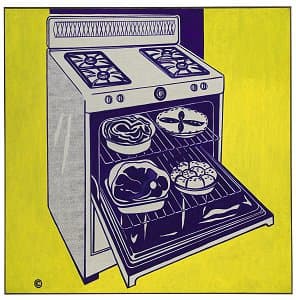

Roy Lichtenstein
Learn moreKitchen range 1961-62
© Estate of Roy Lichtenstein/Copyright Agency Purchased 1978
More detail | PermalinkIn the summer of 1961 Roy Lichtenstein abandoned his earlier Abstract Expressionist style and began to use commercial art as the subject matter of his painting. Kitchen range, painted in the winter of 1961–62, was among the first of these works. Its source was probably an advertisement: the painting mischievously retains the copyright symbol located in the lower left-hand corner, and the Ben Day dots used by printers to reproduce tone. The dots in Kitchen range and other early works were laboriously reproduced by hand, and only later by mechanical means. Lichtenstein stated that it was his intention to follow the original commercial reproduction as closely as possible: ‘The closer my work is to the original the more threatening and critical the content.’[1]
The colours of Kitchen range, limited to yellow and blue, are typical of the restricted palette of the early works. Lichtenstein explained in a 1971 interview that he was ‘looking for the most contrast’:
Each colour had a certain character to me: the yellow was acid, and a colour that seemed to contrast as much as possible with it was a blue that was almost violet … I got some of these colours from supermarket packaging. I would look at package labels to see what colours had the most impact on one another. The idea of contrast seemed to be what advertising was into in this case. An advertisement is so intensely impersonal![2]
The overall quality of the yellow background in Kitchen range, with only the block of blue to suggest a door or edge of the wall, also highlights the patterns and general busyness of the appliance, its components and contents. The stove’s ‘jaunty’ angle provides dynamism to the composition while emphasising the food items presented and projecting from its interior. The pattern of the apple pie is reprised in the hobs above, while the organic forms of the leg of ham contrast with the linear racks.
The placement of the image on a neutral ground—a composition the artist described as ‘anti-Cubist’[3]—is repeated in other works of 1961–63. The square format of Kitchen range complements the object’s geometry, while the central placement of the smaller appliance in Roto-broil 1961 emphasises its more baroque curves.[4] Elsewhere Lichtenstein varies the dimensions of his canvases to enhance the form of his chosen object: in Washing machine 1961,[5] for example, a more rectangular format draws attention to the angles and upper surface of the top-loader, while Cherry pie 1961, Golf ball 1962 and Hot dog with mustard 1963 are likewise closely cropped to complement the item depicted.[6] Through consistent means, and using only a small number of variants to depict food and other consumer goods of postwar America, Lichtenstein suggests the mass production and affluence of the period.
Lucina Ward[7]
[1] John Coplans, ‘An Interview with Roy Lichtenstein’, Artforum, vol 2, no 4, October 1963, p 31.
[2] Diane Waldman, Roy Lichtenstein, Thames and Hudson, London, 1971, p 26.
[3] ‘You pick an object and put it on a blank ground. I was interested in non-Cubist composition. The idea is contrary to the major direction of art since the early Renaissance which has more and more symbolised the integration of “figure” and “ground”.’ John Coplans, ‘Talking with Roy Lichtenstein’, Artforum, vol 5, no 9, May 1967, pp 34–9; see also Phyllis Tuchman, ‘Pop! Interviews with George Segal, Andy Warhol, Roy Lichtenstein, James Rosenquist and Robert Indiana’, Artnews, vol 73, no 5, May 1974, pp 24–9.
[4] Museum of Contemporary Art, Tehran.
[5] Yale University Art Gallery, Connecticut, at https://artgallery.yale.edu/collections/objects/60636, accessed 3 April 2018.
[6] Cherry pie 1961, ex collection Sydney and Frances Lewis, Richmond; at auction Christie’s New York, November 2010, at http://www.christies.com/lotfinder/Lot/roy-lichtenstein-cherry-pie-5371728-details.aspx, accessed 3 April 2018; Golf ball 1962, private collection; Hot dog with mustard 1963, Aaron I Fleischman.
[7] Adapted and updated from Michael Lloyd and Michael Desmond, European and American paintings and sculptures 1870–1970 in the Australian National Gallery, Australian National Gallery, Canberra, 1992, pp 316–18.

